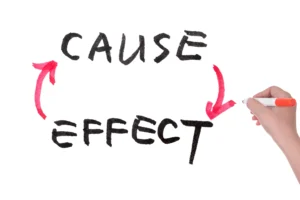Causation: Proving the Link Between Actions and Injuries
Table of Contents
 Causation is a key element in any personal injury case. It serves as the connection between the defendant’s actions and the plaintiff’s injuries. Proving causation is crucial to recover compensation for injuries resulting from accidents. This article breaks down the elements of causation in personal injury cases, explaining why it’s important and how you can prove it in court.
Causation is a key element in any personal injury case. It serves as the connection between the defendant’s actions and the plaintiff’s injuries. Proving causation is crucial to recover compensation for injuries resulting from accidents. This article breaks down the elements of causation in personal injury cases, explaining why it’s important and how you can prove it in court.
What Is Causation in a Personal Injury Case?
Causation is a fundamental concept in personal injury law that refers to the cause-and-effect relationship between the defendant’s actions and the plaintiff’s injuries. For a plaintiff to succeed in a personal injury case, it’s not enough to show that the defendant acted negligently; the plaintiff must also prove that the defendant’s actions directly led to the harm they suffered. This is where causation comes into play.
Causation is critical because the plaintiff cannot hold the defendant legally responsible for their injuries without it. Even if the defendant breached their duty of care, the case cannot proceed unless the plaintiff can establish that this breach caused the injury in question. Proving this link is essential in securing compensation for the plaintiff’s damages, whether they are medical bills, lost wages, or pain and suffering.
 For example, causation in personal injury cases can be compared to pushing over a domino that triggers the rest to fall. The initial push represents the defendant’s actions, while the falling dominoes symbolize the chain of events leading to the plaintiff’s injuries. Just like the first domino sets off a sequence that results in the others falling, the defendant’s negligence starts a chain of events that causes harm. For causation to be proven, it must be shown that, without the initial push (the defendant’s actions), the injury would not have occurred.
For example, causation in personal injury cases can be compared to pushing over a domino that triggers the rest to fall. The initial push represents the defendant’s actions, while the falling dominoes symbolize the chain of events leading to the plaintiff’s injuries. Just like the first domino sets off a sequence that results in the others falling, the defendant’s negligence starts a chain of events that causes harm. For causation to be proven, it must be shown that, without the initial push (the defendant’s actions), the injury would not have occurred.
What Are the Two Types of Causation?
In personal injury cases, causation is typically broken down into two primary components:
Actual Cause (Cause in Fact)
Actual cause, often referred to as “cause in fact,” focuses on whether the injury would have occurred “but for” the defendant’s actions. In other words, the plaintiff must show that their injury would not have happened without the defendant’s negligence.
Proximate Cause
Proximate cause deals with whether the injuries were a foreseeable result of the defendant’s actions. It ensures that the cause-and-effect chain is reasonable and predictable. This element prevents defendants from being held responsible for injuries that were too far removed or unforeseeable due to their actions.
Together, actual cause and proximate cause form the legal framework for proving that the defendant’s actions caused the plaintiff’s injuries. It becomes challenging to hold the defendant liable in a personal injury case without establishing both.
Why Is Proving Causation Essential in Personal Injury Claims?
Proving causation is critical in any personal injury claim because it directly determines whether the plaintiff can recover compensation for their injuries. While it may be clear that the defendant acted negligently—whether by speeding, failing to maintain safe premises, or ignoring safety regulations—negligence alone is not enough to establish liability. The plaintiff must demonstrate that this negligence directly caused their injuries. This makes causation a key hurdle in personal injury cases.
Causation links the defendant’s actions to the harm suffered by the plaintiff. Without this connection, the defendant cannot be held legally responsible for the damages, regardless of how reckless or careless they may have been. This means that even if the defendant clearly breached their duty of care, such as by running a red light or failing to fix a dangerous condition on their property, the plaintiff still needs to demonstrate that the breach was the actual cause of their injury.
For example, in a car accident case, it may be clear that the defendant was negligent in running a red light. However, to recover compensation, the plaintiff must prove that the car accident and resulting injuries were directly caused by the defendant’s failure to stop at the light. If the plaintiff cannot establish that the collision caused the injuries—perhaps the plaintiff had a pre-existing injury or another driver partially caused the accident—then proving causation becomes much more difficult. The connection between the defendant’s negligence and the injuries is crucial for the success of the case.
Without proving causation, the plaintiff’s claim is likely to fail, as they cannot hold the defendant liable for injuries that were not a direct result of the defendant’s actions. This step is crucial for the plaintiff to secure compensation for medical expenses, lost wages, pain and suffering, and other damages resulting from the injury. Therefore, establishing causation is a foundational requirement for personal injury claims to succeed.
Do You Have Questions About Causation?
Proving Causation in Personal Injury Cases
To prove causation, the plaintiff must show that the defendant’s actions were the actual and proximate cause of their injuries. Proving causation may involve presenting evidence such as medical records, expert witness testimony, or accident reconstruction reports. The stronger the evidence, the better the chances of proving causation.
What Is the Role of Comparative Fault in Causation?
Comparative fault allows for the plaintiff and defendant to share responsibility for an accident. If the plaintiff contributed to the cause of their injuries, their compensation may be reduced in proportion to their percentage of fault. Understanding how comparative fault interacts with causation is crucial in personal injury claims.
How Does Causation Affect the Outcome of a Personal Injury Case?
The plaintiff must prove that the defendant’s conduct was both the factual and legal cause of their injuries. Failure to do so can result in a dismissal of the case. Causation is one of the most contested aspects of personal injury litigation, and the outcome of a case often hinges on successfully proving this element.
Causation and Complex Injury Cases: Challenges and Solutions
Establishing causation can be particularly challenging in cases involving complex injuries or multiple defendants. In such cases, various causes may contribute to the injury, and it becomes essential to identify and separate these factors to determine legal liability. Expert testimony and detailed evidence can be critical to success.
How Can a Personal Injury Lawyer Help Prove Causation?
Working with our personal injury law firm can help you gather the necessary evidence to prove causation. A personal injury lawyer from Allbee Law Firm can guide you through the legal process, helping establish the elements of negligence and ensuring you have the best possible chance of winning your personal injury case.
If you have been injured and believe someone else’s negligence caused your injury, contact Allbee Law Firm at (972) 848-4848 to schedule a free consultation with an experienced Dallas personal injury lawyer today.
Personal Injury Causation FAQs
How Does Negligence Relate to Causation?
Causation is a core element of any negligence claim, as it forms the link between the defendant’s breach of duty and the plaintiff’s injuries. In personal injury cases, proving negligence requires the plaintiff to establish four essential elements: duty of care, breach of duty, causation, and damages. These elements work together to show that the defendant acted negligently, and without proving each one, the claim may fail.
First, the plaintiff must show that the defendant owed them a duty of care—a legal obligation to act reasonably to avoid harming others. For example, all drivers have a duty of care to follow traffic laws and drive safely to avoid causing accidents.
Second, the plaintiff must demonstrate that the defendant breached this duty by acting in a way that a reasonably prudent person would not have, such as by speeding, running a red light, or texting while driving. This breach shows that the defendant’s actions deviated from the expected standard of care.
Next comes causation, which is where the plaintiff must establish that the defendant’s breach directly caused their injuries. Even if it is clear that the defendant acted negligently, if the plaintiff cannot show a direct cause-and-effect relationship between the defendant’s actions and their injuries, the claim cannot succeed. For instance, if a driver runs a red light but the plaintiff’s injuries were caused by a different factor, such as faulty brakes in their own vehicle, proving causation becomes difficult.
Finally, the plaintiff must prove damages, meaning they suffered actual harm, such as medical bills, lost wages, or pain and suffering, due to the defendant’s actions. Without damages, there is no basis for a claim.
In summary, causation is the bridge between a defendant’s breach of duty and the harm suffered by the plaintiff. Without establishing this crucial link, even the most blatant breach of duty will not result in a successful negligence claim.
What Role Does an Expert Witness Play in Proving Causation?
Expert witnesses play a crucial role in proving causation, particularly in complex personal injury cases where the connection between the defendant’s actions and the plaintiff’s injuries may not be immediately apparent. These professionals—often doctors, accident reconstruction specialists, engineers, or other experts in relevant fields—provide specialized knowledge and testimony that can make or break a case. Their insights help clarify the technical, medical, or scientific aspects that are beyond the understanding of the average juror or judge, making them indispensable in many personal injury claims.
For instance, in a car accident case, a medical expert might testify about the nature of the plaintiff’s injuries, explaining how the collision caused specific harm, such as whiplash or a traumatic brain injury. This type of testimony is essential in demonstrating that the plaintiff’s injuries were not due to pre-existing conditions or other unrelated factors but were a direct result of the accident. Similarly, an accident reconstruction expert can analyze the scene of the accident and the vehicles involved, offering insights into how the crash occurred and whether the defendant’s actions, such as speeding or failing to brake, were responsible for causing the collision.
Expert witnesses are also invaluable in helping to disprove alternate theories of causation presented by the defense. The defendant may argue that the plaintiff’s injuries were caused by another factor, such as an unrelated incident or a medical condition that existed before the accident. In such situations, expert witnesses can present evidence to refute these claims and demonstrate that the defendant’s actions were the primary cause of the injury.
Overall, expert testimony can provide clear, authoritative explanations that strengthen the plaintiff’s case by offering objective evidence to establish the crucial link between the defendant’s conduct and the plaintiff’s injuries. Without such expert insights, proving causation in more complicated cases can be challenging, especially when the details are highly technical or require specialized knowledge to interpret.
